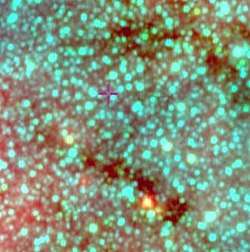VVV-WIT-07
VVV-WIT-07 is a unique variable star which presents a sequence of recurrent dimmings (v~14.35 – 16.164)[1] with a possible deep eclipse in July 2012. The star, located in the Scorpius constellation about 23,000 ly (7,100 pc)(?) away,[1] is not a binary star, which would eliminate such a system from explaining the various observed dimmings.[2]
 Context star field of VVV-WIT-07 | |
| Observation data Epoch Equinox | |
|---|---|
| Constellation | Scorpius |
| Right ascension | 17h 26m 29.387s[1] |
| Declination | −35° 40′ 6.20″[1] |
| Apparent magnitude (V) | 14.35 – 16.164[1] |
| Characteristics | |
| Astrometry | |
| Details | |
| Other designations | |
| Database references | |
The star was found by the "Vista Variables in the Via Lactea" (VVV) project, which is a survey of European Southern Observatory (ESO) variability of the innermost bulge of the Milky Way galaxy. The near-infrared spectra of VVV-WIT-07 appear without features, without prominent emission or absorption lines. The characteristics found in the light curve of VVV-WIT-07 (WIT refers to "What Is This?") are similar to those seen in J1407 (Mamajek's Object), a pre-MS K5 dwarf with a ring system that eclipses the star or, alternatively, to KIC 8462852 (or Tabby's star), a F3 IV/V star that shows irregular and aperiodic obscurations in its light curve.[1][3][4][5][6][7][2]
From 2010 to 2018, the star dimmed and brightened irregularly (v~14.35 – 16.164),[1] and seemed similar to Tabby's star, except the light from VVV-WIT-07 dimmed by up to 80 percent, while Tabby’s star faded by only about 20 percent.[7] Another star, J1407, however, has been found to have dimmed by up to 95%, which may be more similar to the light curve presented by VVV-WIT-07.[7] Nonetheless, according to ESO astronomer Valentin Ivanov, "A key word that could be used to describe our finding [of VVV-WIT-07] is extreme. In every aspect ... We have identified a system that challenges the imagination even more than usual, because it is so unlike our own planetary system."[2]
References
- Saito, Roberto K.; et al. (2019). "VVV-WIT-07: another Boyajian's star or a Mamajek's object?". Monthly Notices of the Royal Astronomical Society. 482 (4): 5000–5006. arXiv:1811.02265. Bibcode:2019MNRAS.482.5000S. doi:10.1093/mnras/sty3004.
- Ivanov, Valentin D. (22 March 2019). "What Is This? - Astronomers discover mysterious star displaying never-seen-before behaviour". European Southern Observatory. Retrieved 9 June 2019.
- Saito, R.K.; et al. (6 November 2018). "VVV-WIT-07: another Boyajian's star or a Mamajek's object?". Monthly Notices of the Royal Astronomical Society. 482 (4): 5000–5006. arXiv:1811.02265. doi:10.1093/mnras/sty3004.
- Seidel, Jamie (23 November 2018). "VVV-WIT-07: This ancient, erratic star hides a dark secret". The Advertiser. Retrieved 8 June 2019.
- Anderson, Paul Scott (29 November 2018). "Have astronomers found another Tabby's Star? - Remember when astronomers found Tabby's Star and said they'd never seen anything like it? Now there's another one … maybe". Earth & Sky. Retrieved 8 June 2019.
- Redd, Nola Taylor (21 November 2018). "Have Astronomers Found Another "Alien Megastructure" Star? - Scientists now have a second example of a strange stellar phenomenon speculatively linked to extraterrestrial intelligence in 2015". Scientific American. Retrieved 8 June 2019.
- Grossman, Lisa (22 December 2018). "Astronomers spot another star that flickers like Tabby's star - It's unclear what's causing the newly discovered object to blink, but it's probably not aliens". Science News. 194 (12). p. 9. Retrieved 8 June 2019.
External links
- Video (13:46) − "Tabby's Star" on YouTube, a presentation by Tabetha S. Boyajian (2016).
- Video (31:00) − "Tabby's Star" on YouTube, a presentation by Issac Arthur (2016).
- Video (01:00) − RZ Piscium on YouTube, star with unusual light fluctuations (2017).
- Video (00:13) – EPIC 204376071 on YouTube, up to 80% dimming.
6.20